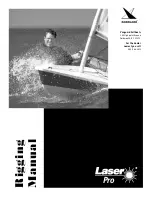
Preparation before departure
Acquire the necessary information and inform other passengers:
1.
Get information on local laws, regulation and hazards related to water activities
and kayak operation.
2.
Check the weather forecast, local currents, tides and wind conditions.
3.
Advise someone on the land of the time you plan to be back.
4.
Determine the distance you can cover and remember that bad weather conditions
can alter this.
Check the working condition of the kayak and equipment
:
1.
Check inflation pressure.
2.
Check all safety valves.
3.
Check the load is evenly distributed on the deck of kayak: front to back and side to
side.
4.
That the footrest will not entangle the feet of the occupants in the event of a
capsize.
Check that required safety equipment is onboard (Check your local/regional laws and
regulations for the location in which you’re kayaking)
1.
One personal flotation device (PFD) for each occupant.
2.
The air pumps, oars, repair kit.
3.
The mandatory equipment.
4.
This user guide and any necessary licenses / paperwork that may be required.
5.
Lights are required if operating after dark.
Rules to observe during navigation
1.
Be responsible and strictly follow the safety rules. Do not neglect the safety rules;
this could endanger your life and lives of others.
2.
Learn to keep control of your kayak.
3.
Respect local regulations and practices.
4.
Navigate on “sheltered water” only.
5.
Keep fire away. Do not smoke on board. Ash and fire can puncture the kayak.
6.
Remember weather conditions can rapidly deteriorate. Always be sure that you can
reach shelter rapidly.
OPERATION
Summary of Contents for KDKX1INFKYA
Page 1: ...KX1 INFLATABLE KAYAK KDKX1INFKYA ...
Page 2: ......






























